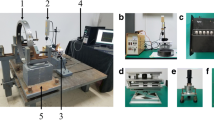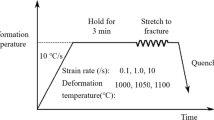Abstract
Ring rolling technology is widely used in the production of GH4738 aerospace rings, but the ring produced by ring rolling often has the phenomenon of uneven stress and unqualified strength. To solve these problems, the thick-walled ring bulge forming technology was proposed. In this paper, a 3D-coupled thermo-mechanical FE model of the GH4738 rectangular ring bulging process was developed, which is verified to be in good agreement with the experimental process. Based on this model, the thermal parameter distribution and evolution of GH4738 rectangular ring during the bulging process were investigated systematically. Then, the evolution of the minimum bulging displacement (BD) required for rings with the change of ring size was obtained by comparing the stress distribution of rings during the bulging process in seven cases. All these provide a theoretical basis for the selection of optimal BD in practical production. Finally, the influence of the bulging process on the microstructure and mechanical properties of GH4738 alloy ring was analyzed by experimental means, and it was verified that the bulging process can play a good role in improving the strength of the ring from the perspective of the average geometrically necessary dislocation (GND) density. The experimental results indicate that with the increase of BD, the grain size of the ring does not change that much, but the average GND density increases gradually, and the yield strength and tensile strength of the ring increase significantly.

























Similar content being viewed by others
References
Lerch BA, Jayaraman N, Antolovich SD (1984) A study of fatigue damage mechanisms in Waspaloy from 25 to 800 °C. Materials Science and Engineering 66(2):151–166
Lynch SP, Radtke TC, Wicks BJ, Byrnes RT (1994) Fatigue crack growth in nickel-based superalloys at 500-700°c. i: waspaloy. Fatigue Fract Eng M 17(3):297–311
Whelchel RL, Kelekanjeri VSKG, Gerhardt RA, Ilavsky J (2011) Effect of aging treatment on the microstructure and resistivity of a nickel-base superalloy. Metall Mater Trans a 42A(5):1362–1372
Wang L, Yang G, Lei T, Yin S, Wang L (2015) Hot deformation behavior of GH738 for A-USC turbine blades. J Iron Steel Res Int 22(11):1043–1048
Wang T (1998) Tube plastic forming technology. China Machine Press, Beijing (In China)
Grey JE, Devereaux AP, Parker WN (1939) Apparatus for making wrought metal T’s. US Patent 868(203):2
Fuchs FJ (1966) Hydrostatic pressure - its role in metal forming. Mech Eng 88(4):34
Al-Qureshi HA (1970) Comparison between the bulging of thin-walled tubes using rubber forming technique and hydraulic forming process. Sheet Metal Ind: 607-612
Koc M, Altan T (2001) An overall review of the tube hydroforming (THF) technology. J Mater Process Tech 108(3):384–393
Wang MW, Zhang LW, Pei JB (2007) Effect of temperature on vacuum hot bulge forming of BT20 titanium alloy cylindrical workpiece. T Nonferr Metal Soc 17(5):957–962
Ramezani M, Ripin ZM, Ahmad R (2009) A static friction model for tube bulge forming using a solid bulging medium. Int J Adv Manuf Tech 43(3-4):238–247
Yoo J, Yoon J, Lee H, Youn S (2012) Material characterization of Inconel 718 from free bulging test at high temperature. J Mech Sci Technol 26(7):2101–2105
Zhu Z, Zhang L, Gu S (2014) FEM analysis of vacuum hot bulge forming of Hastelloy C-276 thin-walled cylindrical workpiece. J Cent South Univ 21(8):3019–3023
Cai G, Lang L, Liu K, Alexandrov S, Zhang D, Yang X, Guo C (2015) Research on the effect of flow stress calculation on aluminum alloy sheet deformation behavior based on warm bulging test. Met Mater Int 21(2):365–373
Cui X, Wang X, Yuan S (2015) The bulging behavior of thick-walled 6063 aluminum alloy tubes under double-sided pressures. Jom-Us 67(5):909–915
Cui X, Mo J, Li J, Xiao X (2017) Tube bulging process using multidirectional magnetic pressure. Int J Adv Manuf Tech 90(5-8):2075–2082
Sizova I, Sviridov A, Bambach M (2017) Avoiding crack nucleation and propagation during upset bulging of tubes. Int J Mater Form 10(3):443–451
Gao T, Zhang W, Xu M, Wang Z (2017) Finite element analysis and experiment on viscous warm pressure bulging of AZ31B magnesium alloy. J Wuhan Univ Technol 32(3):640–644
Wu K, Li X, Ge Y, Ruan S (2018) Determination of tubular material parameters in bulging test with three-dimensional digital image correlation method. Int J Adv Manuf Tech 96(5-8):2091–2099
Yang L, Zhao Q (2019) Forming limit diagrams for tubes with non-uniform thickness in hydro-bulging. Int J Adv Manuf Tech 103(1-4):901–911
Jiang J, Britton TB, Wilkinson AJ (2013) Evolution of dislocation density distributions in copper during tensile deformation. Acta Mater 61(19):7227–7239
Bai G, Li J, Hu R, Tang Z, Xue X, Fu H (2011) Effect of temperature on tensile behavior of Ni–Cr–W based superalloy. Materials ence & Engineering A 528(4-5):1974–1978
Sablik MJ, Stegemann D, Krys A (2001) Modeling grain size and dislocation density effects on harmonics of the magnetic induction. J Appl Phys 89(11):7254–7256
Funding
This work was supported by the Key Research and Development Program of Shaanxi (2020GY-253) and Natural Science Basic Research Program of Shaanxi (No.2020JQ-182).
Author information
Authors and Affiliations
Corresponding authors
Ethics declarations
Consent to publish
This manuscript is approved by all authors for publication.
Competing interests
The authors declare no competing interests.
Additional information
Publisher’s note
Springer Nature remains neutral with regard to jurisdictional claims in published maps and institutional affiliations.
Rights and permissions
About this article
Cite this article
Hu, Y., Liu, D., Yang, Y. et al. Experimental and numerical analysis on bulge forming process of GH4738 thick-walled ring. Int J Adv Manuf Technol 113, 1591–1604 (2021). https://doi.org/10.1007/s00170-021-06705-3
Received:
Accepted:
Published:
Issue Date:
DOI: https://doi.org/10.1007/s00170-021-06705-3




